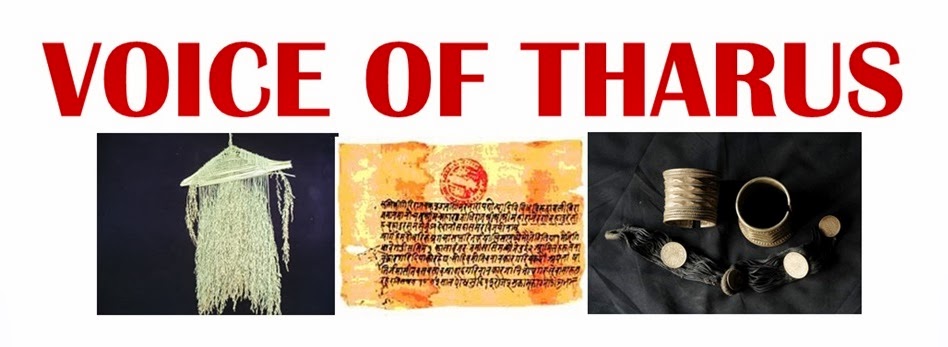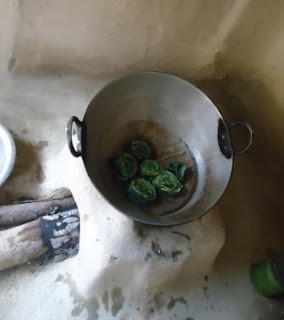Ghonghi (water snails)
Ghonghi is eaten throughout the Terai by Tharus and other indigenous people as a delicacy. It is found in abundance in the ponds, rivers, paddy fields and ditches. It's easy to cook and delicious to eat.
This is how you can prepare the dish.
Collect the snails from water sources.
Leave the collected snails overnight in a vessel containing water to get rid of the soil and waste inside the snail shells. Sprinkle rice (the broken pieces during milling which are not eaten – called khudi). The snails eat the rice pieces and throw away the waste.
Next morning, cut the tails so that when cooked it is easier to suck the meat out of the shell.
Wash and rinse the snails thoroughly.
Boil the snails for almost half an hour.
Rinse the water and cook the snails like other regular curries (Fry onions, chillis and other spices in mustard oil, add the boiled snails and finally add water).
Add ground linseed which not only makes the gravy thicker but also enhances the taste.
Now eat delicacy with rice.
If you want to get rid of sucking the meat out of the shells, take out the meat from the shell after boiling with the help of forceps or a toothpick. Fry the meat in mustard oil, add onions, spices and your dish is ready to be eaten with puffed rice.
For more information on snail and its nutritional value read the below article.
http://tharuculture.blogspot.com/2011/12/excuse-me-its-escargot.html
Bagiya (rice flour dumplings)
Bagiya is a healthy and delicious dish eaten during the Shukrati (Deepawali) festival in eastern Terai of Nepal. You don't need to wait for the festival of lights to savour the taste of bagiya. You will just need some rice flour, lentils, spices and a pot of boiling water to prepare it. Follow the steps below and your dish is ready.
Soak the rice is soaked in water and mill it in a dheki, the traditional rice milling machine. The taste of the flour ground in a dheki is many times better than the one ground in a rice mill.
Sift the flour and fry it in an iron cauldron (Don't add oil and keep in mind not to burn the flour).
Mix warm water to the flour and knead enough to prepare a tender dough.
Steam lentils and add spices, ginger, mustard oil and salt to it.
Make round dumplings out of the dough. Bore a hole, put the mixture of lentils and spice and flatten it with the palms at the middle and leave both the ends protruding out.
Steam the dumplings over a clay pot of boiling water.
Serve the steamed bagiya with chutney or vegetable curry.
While Tharus in the Eastern Nepal prefer flat bagiya with lentils, the Tharus in the Western Nepal prepare bagiya of tubular shape, without lentils in it. To read more about bagiya, click the link below.
http://www.tharuculture.blogspot.com/2012/12/bagiya-rice-flour-dumplings-made-tharu.html
Sidhara (taro, turmeric and dried fishes)
Sidhara is prepared from taro stem, turmeric, and dried fishes. The aroma is pungent, the taste is bitter and still it is one of the delicacies eaten by the Terai dwellers especially indigenous peoples like the Tharus, Danuwars, Musahars and others.

This is how you can prepare the dish.
Gather the Dedhna and Ponthi varieties of fish. Both the varieties are found in abundance in the paddy fields and public water sources.
Dry the fishes on sun. It will take few days to dry perfectly.
Gather Kachu (taro – Colocasia) stems and cut them into small pieces. Wash them thoroughly.
Grind or mill the dried fishes, together with the colocasia stem and turmeric, and make small cakes.
Leave the cakes to dry on the sun for 10-15 days and after that store it in a dry place for future use. Your sidhara is then ready to cook and eat.
To cook the sidhara, crumple and break the cakes into tiny crumbs. Fry the pieces of sidhara in mustard oil together with onion, green chillies, radish and spices. Add water and salt to taste.
Garnish the dish with green coriander leaves and serve with puffed and beaten rice.
If you want to know more about sidhara, read the below article.
http://tharuculture.blogspot.com/2011/12/sidhara-colocasia-concoction.html
Ghonghi is eaten throughout the Terai by Tharus and other indigenous people as a delicacy. It is found in abundance in the ponds, rivers, paddy fields and ditches. It's easy to cook and delicious to eat.
This is how you can prepare the dish.
Collect the snails from water sources.
Leave the collected snails overnight in a vessel containing water to get rid of the soil and waste inside the snail shells. Sprinkle rice (the broken pieces during milling which are not eaten – called khudi). The snails eat the rice pieces and throw away the waste.
Next morning, cut the tails so that when cooked it is easier to suck the meat out of the shell.
Wash and rinse the snails thoroughly.
Boil the snails for almost half an hour.
Rinse the water and cook the snails like other regular curries (Fry onions, chillis and other spices in mustard oil, add the boiled snails and finally add water).
Add ground linseed which not only makes the gravy thicker but also enhances the taste.
Now eat delicacy with rice.
If you want to get rid of sucking the meat out of the shells, take out the meat from the shell after boiling with the help of forceps or a toothpick. Fry the meat in mustard oil, add onions, spices and your dish is ready to be eaten with puffed rice.
For more information on snail and its nutritional value read the below article.
http://tharuculture.blogspot.com/2011/12/excuse-me-its-escargot.html
Bagiya (rice flour dumplings)
Bagiya is a healthy and delicious dish eaten during the Shukrati (Deepawali) festival in eastern Terai of Nepal. You don't need to wait for the festival of lights to savour the taste of bagiya. You will just need some rice flour, lentils, spices and a pot of boiling water to prepare it. Follow the steps below and your dish is ready.
Soak the rice is soaked in water and mill it in a dheki, the traditional rice milling machine. The taste of the flour ground in a dheki is many times better than the one ground in a rice mill.
Sift the flour and fry it in an iron cauldron (Don't add oil and keep in mind not to burn the flour).
Mix warm water to the flour and knead enough to prepare a tender dough.
Steam lentils and add spices, ginger, mustard oil and salt to it.
Make round dumplings out of the dough. Bore a hole, put the mixture of lentils and spice and flatten it with the palms at the middle and leave both the ends protruding out.
Steam the dumplings over a clay pot of boiling water.
Serve the steamed bagiya with chutney or vegetable curry.
While Tharus in the Eastern Nepal prefer flat bagiya with lentils, the Tharus in the Western Nepal prepare bagiya of tubular shape, without lentils in it. To read more about bagiya, click the link below.
http://www.tharuculture.blogspot.com/2012/12/bagiya-rice-flour-dumplings-made-tharu.html
Sidhara (taro, turmeric and dried fishes)
Sidhara is prepared from taro stem, turmeric, and dried fishes. The aroma is pungent, the taste is bitter and still it is one of the delicacies eaten by the Terai dwellers especially indigenous peoples like the Tharus, Danuwars, Musahars and others.

This is how you can prepare the dish.
Gather the Dedhna and Ponthi varieties of fish. Both the varieties are found in abundance in the paddy fields and public water sources.
Dry the fishes on sun. It will take few days to dry perfectly.
Gather Kachu (taro – Colocasia) stems and cut them into small pieces. Wash them thoroughly.
Grind or mill the dried fishes, together with the colocasia stem and turmeric, and make small cakes.
Leave the cakes to dry on the sun for 10-15 days and after that store it in a dry place for future use. Your sidhara is then ready to cook and eat.
To cook the sidhara, crumple and break the cakes into tiny crumbs. Fry the pieces of sidhara in mustard oil together with onion, green chillies, radish and spices. Add water and salt to taste.
Garnish the dish with green coriander leaves and serve with puffed and beaten rice.
If you want to know more about sidhara, read the below article.
http://tharuculture.blogspot.com/2011/12/sidhara-colocasia-concoction.html






